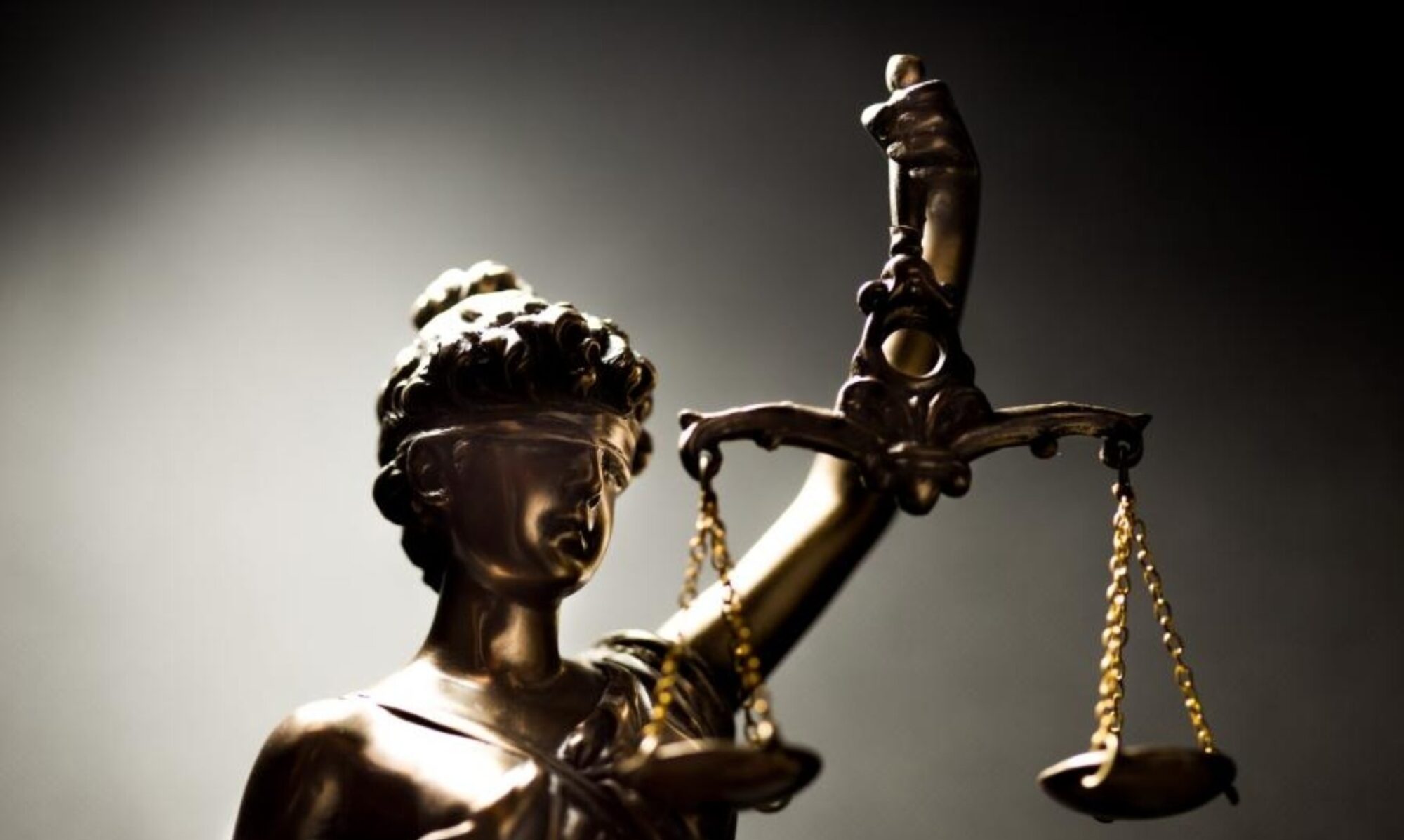Рисунки на униформи
INTRODUCTION
After the end of the 1st Balkan War & the signing of the London peace treaty between the Balkan states and the Ottoman Empire (May 17th, 1913) the allied Balkan countries felt that the time had come for them to settle their differences regarding the conquered territories.
Serbia, Montenegro and Bulgaria had already signed an agreement and settled their territorial disputes, but Serbia at the end did not recognise the agreement, since at first it believed that Albania would finally be part of Serbia, thus gaining access to the Adriatic sea. The treaty provided for an independent Albanian state and Serbia’s gains to the west were reduced. Bulgaria, however, insisted to annex all the agreed territories. While Serbia recognised as a Greek right the annexation of all the liberated territories, Bulgaria sought to drive Greece out from those territories and create the Great Bulgaria of the 1878 Saint Stephan Treaty.
Greece and Serbia, since May 19, 1913 , had signed a defensive alliance. Bulgaria had already made a decision for a surprise attack against the Greek and Serbian army. Thus, during the night of 16-17 June, 1913 , the Bulgarians without any official declaration of war surpassingly attacked the Greeks and the Serbs, achieving to occupy Gevgeli , cutting off communication between the Greeks and the Serbs. The Bulgarian generals seemed sure of victory even if the facts on the ground would put their optimism to question. To quote general Savov heading the Bulgarian army and perhaps the main proponent of war on the quality of the opposing armies and the expected timetable, „Thessaloniki will be captured within 9 hours and Belgrade within 5 days. The Greeks are an army of peddlers and traders and the Serbs were soundly defeated back in 1885“. The 2 Bulgarian battalions in Thessaloniki/Salonika waited for their comrades to join them within a day.
Major General Kalaris , CO of the Greek II Division, sent to the CO of the Bulgarian forces in Thessaloniki, Hessapsyev, the following message:
„Commander Sir,
Since the Bulgarian troops have started hostilities in the countryside against our Army, I have the honour to request you to leave the city of Thessaloniki whithin the hour after the delivery of this message.
The weapons of your men must be delivered to our officers, while your officers may keep their swords. A train will transport your men to the front and will be taken measures to allow them pass safely the front line. At the end of this deadline, with big sorrow, your troops will be considered hostile.
In Thessaloniki,
17 June 1913“
As it was expected, the Bulgarians denied the ultimatum & by the afternoon of June 17 they were attacked by the II Greek division & the Cretans of the Cretan Gendarmerie and forced to surrender.

1st Class Gendarme of the Cretan Gendarmerie in Salonika in 1913

Left: The Greek Army National Cockade. Right: The Cretan Gendarmerie Cockade with the Royal cypher of the Greek Prince George II who was the High Commissioner on the island
On the 18th, the Greek army was on the move against the Bulgarians in the Kilkis-Lahana position which Ivanov had taken considerable care to fortify in the past 9 months.
THE BATTLE OF KILKIS-LACHANA
![]()
The area offered many defence advantages because the ground is totally uncovered and offers perfect observation and fire fields. Holding this line, the Bulgarians, were able to secure Serrae, Siderocastron, Doiran and Gevgeli, to control the Strymon river bridges , which were important for their re-supply, while they secured their withdrawal in case of an emergency.
The Bulgarians deployed 32 Infantry Battalions, 1 Cavalry Regiment and 62 Artillery guns (III Infantry Division, 1/X Infantry Brigade, 2 Independent Infantry Brigades, XI Infantry Division in reserve, 5th Border Battalion, 10th Border Battalion, 10th Cavalry Regiment) . Field Marshal was General Ivanov .
The overall forces of the Greek Army were 73 Infantry Battalions, 33 Field Artillery Battalions, 9 Mountain Artillery Battalions, 8 Cavalry Squadrons and 8 Cavalry Troops (I,II,III,IV,V,VI,VII,X Infantry Division, the Cavalry Brigade). Commander in Chief was King Constantine

During the night of June 19th, 1913, 4 Greek Divisions (II, III, IV,V) and the Cavalry Brigade moved to occupy Kilkis City . They met the Bulgarian outposts force which are fought obstinate. A bloody and tough fight was conducted and Greek forces gained the land foot by foot. The 1st Infantry Regiment was in the Mandres village heights and east of Pikrolimni was the 16th Infantry Regiment. While the day went by, the attack was generalised. The Divisions faced severe casualties but in the end the Bulgarians were forced to withdraw towards the Lipsidrion-Mavroneri Height-Gynaekocastro Line . The dark is coming. During the day that followed the Bulgarians withdrew but the war was not over yet.
Early in the morning of June 20, 1913 , the Regiments of the V Division (16th-22nd-23rd) after a tough and bloody fight occupied the Kristoni rail station, the southern part of the Kristoni village and the surrounding heights . However, despite their courageous efforts they could not march towards Kilkis because the Bulgarians were constantly bombing the ground. The IV Division fought courageously and by mid-day occupied the eastern parts of the Kristoni heights and made contact with the main line of defence of the enemy. The casualties were tremendous. The II Division marched under the fire of the Bulgarians, overrided the enemy and occupied the eastern parts of the Potamia village heights . The III Division , after a tough fight, overrided the Bulgarians and occupied the Levendochori, Baptistis and Megali Vrisi villages .
The Cavalry Brigade marched towards the Megali Vrisi and Kastanies villages but due to arrival of enemy re-enforcement’s (elements of the XI Infantry Division), was forced to retreat, with heavy casualties.
Despite the victories of the Greek Army, Kilkis town was still under Bulgarian hands. However it had to be occupied at all cost. Full of agony, the Commander in Chief sent to all Divisions his historic order, which showed the depth of his agony, but also showed his unbending will for victory:
„Tomorrow, I demand the fall of Kilkis“ .
Early in the morning of June 21, 1913, at 03:30 the attack towards Kilkis commenced. The heroic Regiments of the II Division (1st and 7th) advanced against the Bulgarians. Within 15 minutes they approached the first enemy defence line.

Men of the 5th Battalion of the 1st Regiment, advance against the Bulgarian entrenchments. During the battle, the 2nd Company, lost its commander Captain Papaspyrou & 2/3 of its force
The Bulgarians fired against the advancing Greeks. At 04:10 early in the morning the enemy defence line was occupied after a tough fight. Behind the first line however was the second enemy defence line, against which the Greek army attacked. At 05:00 in the morning the second line fell too and the Greek forces moved against the third and most important defence line. An unequal fight is conducted. The Greeks were marching dauntless under enemy fires. The Bulgarians defended their position obstinate.
The 3rd Regiment was also engaged in battle . The Bulgarians conducted strong counter-attacks. New attacks followed by the Greeks. The Regiments were constantly gaining ground, occupied the third line positions and drove out the Bulgarians.
The other Divisions ( IV, V and III ) deployed around Kilkis and continued from the early ours of the day their fight against the Bulgarians. The Bulgarians provided for strong resistance and with the Artillery engaged the Greeks. The fight however, continued. At 11:00 Kilkis was occupied and at 11:15 the Greek flag was proudly hoisted on Saint George height. The Bulgarians withdrew all over the front.
-The famous French General Debeney , ( Commander of the French Première Armée-1st Army- in WWI), when in 1913 visited the Kilkis-Lachana battle field, was surprised of the Greek Army’s deployment, all 8 divisions packed in a small field, without reserves, unable to perform any sort of manoeuvers. He stated: „This tactic was neither French, nor German…it was simply Greek“.
-General Ivanov , Field Marshal of the Bulgarian forces, writes in his memoirs: „We were able to hold on for so long, because the enemy was clampsy, they could not estimate how serious our situation was, they could not exploit over our difficulties….I thought I had predicted everything though, I had guessed of everything, everything but the Greek madness“.
The 3-day battle of Kilkis was over. The victory proved important and prejudged the outcome of the 2nd Balkan War. From Kilkis, the Greek Army marched towards Doiran, Kerkini, Strumnitsa, Deli Risar and Kressna straits. The victory was great, so were the casualties: 8,652 men killed & injured (37 Officers killed, 85 injured) . There are no official records of the Bulgarian casualties. The Bulgarian POWs were 2,500 Officers & men.

Gerasimos Raphtopoulos (left) is the youngest ever NCO in the history of the Greek Armed Forces . He was born in Fiscardo, Cephallonia in 1900. During the 1st Balkan War, against the Ottomans, he volunteered at the age of 12 & was accepted as private of the 18th Infantry Regiment of the IV Division . For his courage in the battle of Sarandaporon he received a Manlicher-Schonauer rifle as a gift. In the battle of Kilkis-Lachana , in 1913, he managed to escape from enprisonment, killing 3 out of the 5 Bulgarian soldiers who had captured him. On his way back, he found a wounded Evzone & carried him with him. For his valour, he was promoted to the Corporal’s rank on August 28th, 1913 at the age of 13
THE EPIC BATTLE OF KRESSNA
On July 18, 1913, the Bulgarians won a defensive victory against the Serbs at Kalimantsi. This enabled them to shift the 1st Army to support the 2nd Army facing the Greeks in the excellent defensive position of Kressna . Greek CiC King Constantine rejected his government’s proposal for an armistice, seeking a decisive victory on the battlefield, especially after the Greek success in the battle of Strumnitsa (June 26) . French military analysts compared Greek Army’s advance towards Strumnitsa, with Hannibal’s or Napoleon’s route across the Alps, due to the intense summer heat, the gnarled terrain and the altitude-1,500 m/4,900 ft. Greeks lost 1,100 men in Strumnitsa.
On 18 July the consolidated Bulgarian army (1st Army under General Vassil Kutinchev, 79,370 men & 2nd Army under General Saravov, 122,748 men) , that had been settled defensively at Simitli, launched attacks on both flanks pushing the Greeks down the Strymon and Mesta River valleys . General Mikhail Savov was the Bulgarian Field Marshal. The Greeks deployed six Infantry Divisions (I, II, IV, V, VI, VII) and the Cavalry Brigade. Greek Field Marshal was the Cretan Major General Emmanuel Manousoyannakis. At noon of July 18 , two Greek Divisions (I, VI) , moved to occupy the Bulgarian fortified position of Hassan Pasha . They met the Bulgarian outposts force which are fought obstinate. Greek troops, fixed bayonets and fought hand to hand with the Bulgarians. The Divisions faced severe casualties. On July 19 , the Bulgarians conducted strong counter-attacks on the center of the Greek front line (VI ID). They exerted so much pressure on the 9th Evzone Battalion of the 1/38 Evzone Regiment (8th-9th Evzone Btns) that General Manousoyannakis sent the 18th Infantry Regiment to their aid. On Height 1378 , the battle was epic. The fight turned to a deadly hand to hand combat. Any sense of humanism was lost. Both sides fought each other with rocks, hands, even teeth. A Cretan soldier dropped his empty rifle and with his bayonet killed two Bulgarians before he was stabbed to death by five others. After the battle, the stab wounds on his dead body accounted for 22. Two Evzones, Sergeant Tolios & Private Makrakis of the 8th Euzone Battalion, fought alone, against a Bulgarian platoon. After the battle, the stab wounds on Tolios’ dead body, accounted for 30. Makrakis was killed by an enemy machine gun volley. Around their dead bodies, a hillock of Bulgarian corpses was formed. Two Evzone Companies under Captain Manolides & Captain Karachristos launched immediately an attack on the Bulgarian entrenchments to avenge their deaths. The battle on 1378 continued for two more days. Major Ioannis Velissariou CO of the 9th Evzone Battalion, was killed on the second day.

The heroic figure of Major Ioannis Velissariou, commander of the 9th Euzone Battalion
In the last day of the battle of Kressna, the Bulgarians launched their final major offensive. The entire 2nd Army conducted a fierce attack on the Greek III & X ID stationed at Petsovo & the VIII ID that was moving from Machomia to Kressna , that shook the entire Greek line. An armistice though, was at hands. Greeks lost around 10,000 men in the ten days of fighting at Kresna.

A popular lithograph that represents the battle on height 1378. Although it’s not historically accurate, it gives an idea of the epic battle. The figure on the right, is Major Velissariou

During the Balkan Wars, the eight Evzone battalions operated independently on the vanguard or the flanks of the army and distinguished themselves for their fighting spirit, but suffered high casualties, especially among officers. The Evzone units, totalled at their height five regiments: 1st Evzone Rgt/former 38th Infantry Rgt, 2/39, 3/40, 4/41, 5/42.
![]()
Greek Infantry Sgt. in 1913

Greek Scout (Proskopos) Sgt. in 1913
Scouts were volunteers mostly from Crete

Greek Infantry Cpt. in 1913

Bulgarian Infantry Lance-Corporal in 1913. He wears leather boots known as „opanker“
![]()
Bulgarian Infantry Sgt in 1913

Bulgarian Artillery Staff Sgt (Feldwebel)

Bulgarian Infantry Colonel

Bulgarian Infantry Lance-Corporal in 1913. He wears leather boots known as „opanker“
Serbian soldiers also had „opanci“ boots during Balkan wars and the Great war. I’ll post later something about Bregalnica battle, when I catch time.
Serbian soldiers also had „opanci“ boots during Balkan wars and the Great war
Some are scanned from this book:

Uniforms of the Balkan Wars
…others are taken from other sources.
If you’re interested, I scanned a few more illustrations:
Greek Army

Army Academy Cpl
![]()
Artillery Cpl

Cavalry Sgt

Engineer Staff Sgt of the 1st Engineer Rgt

Artillery 1st Lt. He’s wearing the M1868 Full Dress (Grand Uniform)

Cavalry Major, wearing the M1870 Service Dress (Small Uniform)

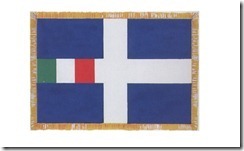
Major of the Garibaldini & their Colours. Italian Volunteers (known as Garibaldini or red-suits), fought alongside the Greek Army, especially in Epirus.
Royal Hellenic Navy

Conscript Able Seaman wearing the winter battle dress
![]()
Conscript Able Seaman wearing the summer service dress

Royal Hellenic Navy Cadet, senior student (4th year), holding the Senior Seaman’s rank

Conscript Able Seaman of the Marines (note the embroidered hunter’s horn under the chevron)

Career Petty Officer

Ensign

Commander MD wearing the Nr2 Formal Uniform
![]()
Vice-Admiral wearing the Nr1 Full Dress
Serbia
![]()
Serbian Army badge. Cyrillic inscription on „ZA KRALJA I OTADZBINU“ („for the King and Fatherland“)

Cavalry Trooper wearing the M1908 Battle Dress

Infantry 1st Lt, wearing the M1890 Full Dress
![]()
Infantry Major wearing the M1912 Service Uniform
![]()
Artillery Col
![]()
Major-General
Montenegro

Infantry Cpl wearing the M1910 Battle Dress & the Obilic medal
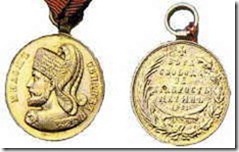
The Milos Obilic Medal

Infantry Cpt wearing the M1910 Battle Dress. The medals are the Danilo I & the Medal for Valour
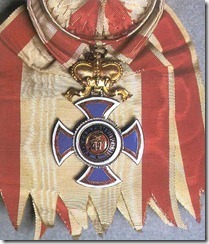
The Prince Danilo I Order
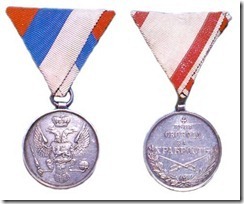
The Medal for Valour „ZA HRABROST-For bravery“
![]()
Militia man of the National Guard, wearing the traditional Montenegrin Uniform
Bulgarian Army
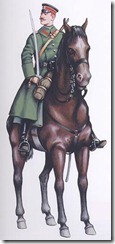
Cavalry Trooper of the 1st Cavalry Rgt. He’s wearing the M1908 Battle Dress (gold King Ferdinand’s cypher Φ on shoulder boards)

Cavalry Trooper of the 2nd Cavalry Rgt. He’s wearing the M1870 Battle Dress
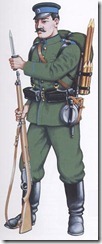
Pvt of the Elite Infantry Regiment „Clementine“. Gold cypher K (for princess Klementina) on shoulder boards
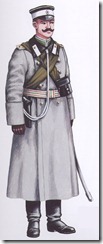
Infantry 2nd Lt of the Elite Infantry Rgt „Ferdinand“. Gold cypher Φ on shoulder boards

Lt.Gen with the M1908 Service Dress
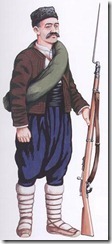
Militia Man of the National Guard (Narodno Opolecnie) with traditional Bulgarian clothing
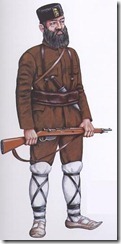
Irregular of the Blgarski Komitet (Bulgarian Committe), operating in Macedonia & Thrace (back then under Ottoman rule). These irregulars fought alongside the Bulgarian Army in 1912 against the Ottomans & in 1913 against the Greeks
Bulgarian Navy

Petty Officer

Lt.Commander
Ottoman Army

Zouave of the Zouave Rgt of the Sultan Guard (Hassa) wearing the Selamlik Uniform

Artillery Gunner wearing the M1909 Battle Dress

Cavalry Trooper wearing the M1909 Battle Dress

Light Infantry Sgt
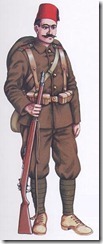
Line Infantry Staff Sgt

Staff Sgt of the 4th Cavalry Rgt of the Sultan Guard

Infantry 2nd Lt. He wears the Kabalak field cap made of Astrakhan fur

Infantry Cpt wearing the M1909 Full Dress

Artillery Cpt wearing the M1909 battle dress

Lt Gen wearing the M1909 Service Dress
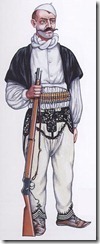
Albanian irregular wearing the Albanian traditional clothing. These irregulars fought alongside the Ottoman Army mostly against the Serbians & Montenegrins (battles of Ipek, Diakova, siege of Shkoder)

Ottoman irregular (Bashi-Buzuk) with the traditional Turkish fez & opanker
Ottoman Navy

Imperial Navy Cadet wearing the M1909 Full Dress. The pin-on metal globe with anchor worn on collars on gold, was the naval academy insignia. The three red stripes on sleeve suggest that he’s a junior student (3rd year)

Marine Petty Officer

Chief Petty Officer wearing the Summer Service Dress
![]()
1st Class Imam, wearing the traditional dress of the muslim clergy
![]()
Lieutenant
![]()
